What is a full set of cutlery?
You're buying new flatware and see terms like "45-piece set" or "service for 12." You feel confused, unsure of what you actually get or what you truly need for your dining table.
A full modern set is based on a 5-piece place setting: a dinner fork, salad fork, dinner knife, soup spoon, and teaspoon. A "full set" for eight people, for example, typically contains 40 pieces plus serving utensils.
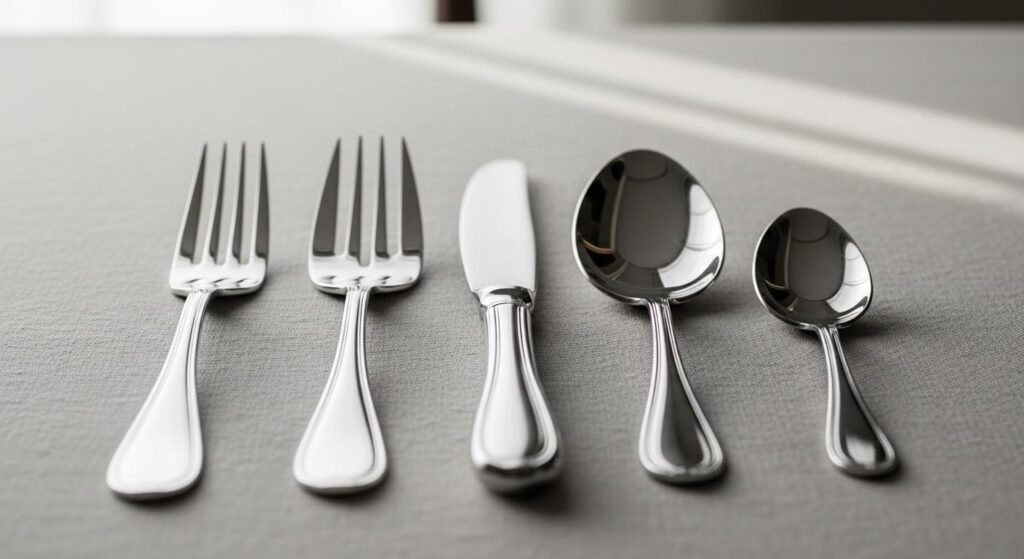
The definition of a "full set" is one of the most common questions I get from clients. A professional buyer for a hotel chain like Jacky will need a very different "full set" than a family buying their first quality set of cutlery. The concept has changed over time and varies hugely across the world. However, in the modern cutlery industry, we do have a clear baseline. Let's break down what a "full set" means today, from the basic essentials to the most elaborate formal arrangements.
How many pieces are in a full cutlery set?
You see sets labeled "20-piece," "45-piece," or "60-piece" and feel lost. You can't easily compare prices or know if a set has everything you need for hosting a dinner party.
A standard retail set is usually 20 pieces (four 5-piece place settings). A 40-piece set serves eight people. A 45-piece set is typically a 40-piece set with a 5-piece "hostess" or serving set included.
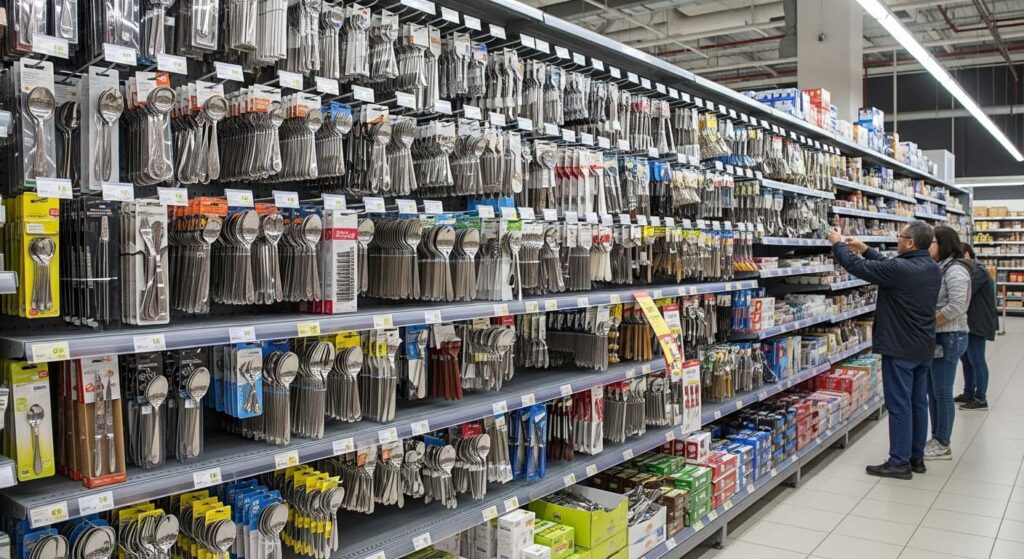
The number of pieces can seem random, but it's based on a simple system of building upon a core place setting. As a manufacturer, we package these sets to meet the most common customer needs. Understanding this system makes shopping much easier.
1. The Core: The 5-Piece Place Setting
This is the modern foundation for almost all Western cutlery sets. It includes one of each of the following:
| Piece | Primary Use |
|---|---|
| Dinner Fork | The largest fork, for the main course. |
| Salad Fork | A smaller fork, for salads or appetizers. |
| Dinner Knife | The main knife, used alongside the dinner fork. |
| Soup Spoon | A large, rounded spoon for soups. |
| Teaspoon | A small spoon for stirring coffee, tea, or for dessert. |
So, a 20-piece set is simply a "service for 4" (4 place settings x 5 pieces). A 40-piece set is a "service for 8" (8 place settings x 5 pieces), and so on.
2. The Addition: The Hostess Set
A truly complete set also helps you serve the food. This is where the serving utensils, often called a "Hostess Set," come in. When you see a 45-piece set, it's almost always a 40-piece set plus these five serving pieces:
- Serving Spoon: A large spoon for serving from a bowl (e.g., potatoes).
- Pierced Serving Spoon: A large spoon with holes to drain liquid.
- Serving Fork: A large fork for serving sliced meats.
- Butter Knife: For a communal butter dish.
- Sugar Spoon: For a sugar bowl.
What is the rule of cutlery?
You are at a formal dinner with an intimidating array of forks, knives, and spoons. You are worried about grabbing the wrong one and making an embarrassing mistake in front of others.
The main rule of cutlery is simple: "work from the outside in." Utensils are placed in the order of use. Use the outermost pieces for the first course and move inward for each subsequent course.
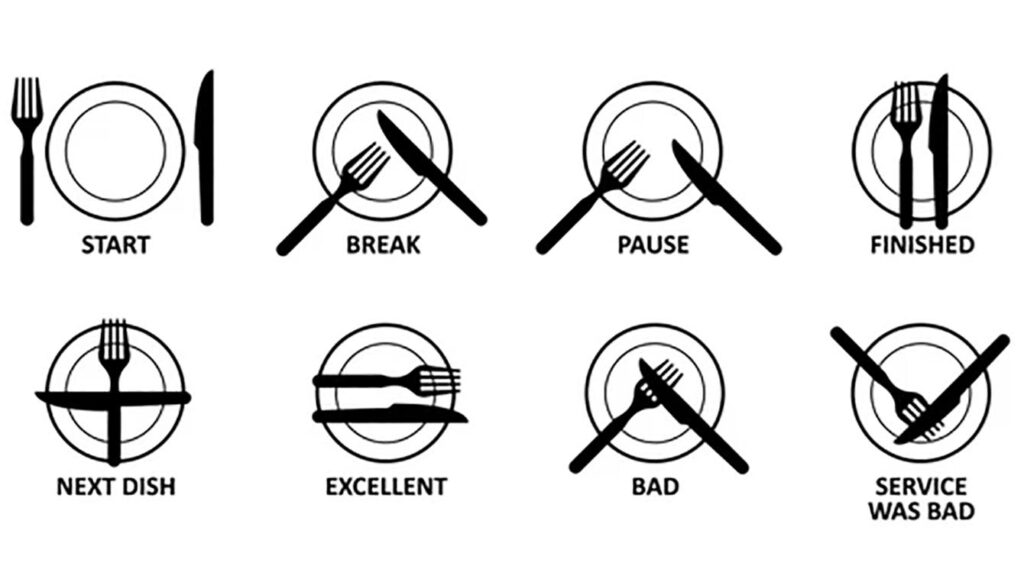
This "outside-in" rule is the secret key to navigating any formal place setting with confidence. The person setting the table has already created a map for your meal. You just have to follow it.
Resting & Finishing Signals
Etiquette also includes how you rest your cutlery during and after the meal. This signals your intentions to your host or the restaurant staff.
- Resting Position: If you are pausing during a meal, you can rest your cutlery in a few ways. The "American style" involves placing your knife at the top edge of the plate (blade in) and resting your fork, tines up, in the center. The "Continental style" involves creating an 'X' shape with the fork (tines down) over the knife.
- Finished Position: This is the most important signal. When you are completely finished with your meal, you place your knife and fork together on the plate. They should be parallel, with the handles pointing toward the bottom right, roughly at the 4 o'clock position. This tells the server, without a word, that your plate can be cleared. It's a universal sign in the dining world.
What is the correct layout for cutlery?
You're hosting an important dinner and want the table to look perfect. You place the plates, but when it comes to the cutlery, you hesitate, unsure of the proper, traditional layout.
The correct layout is logical. Forks go on the left of the plate. Knives and spoons go on the right. The knife blade always faces the plate. As with usage, they are arranged from the outside-in.
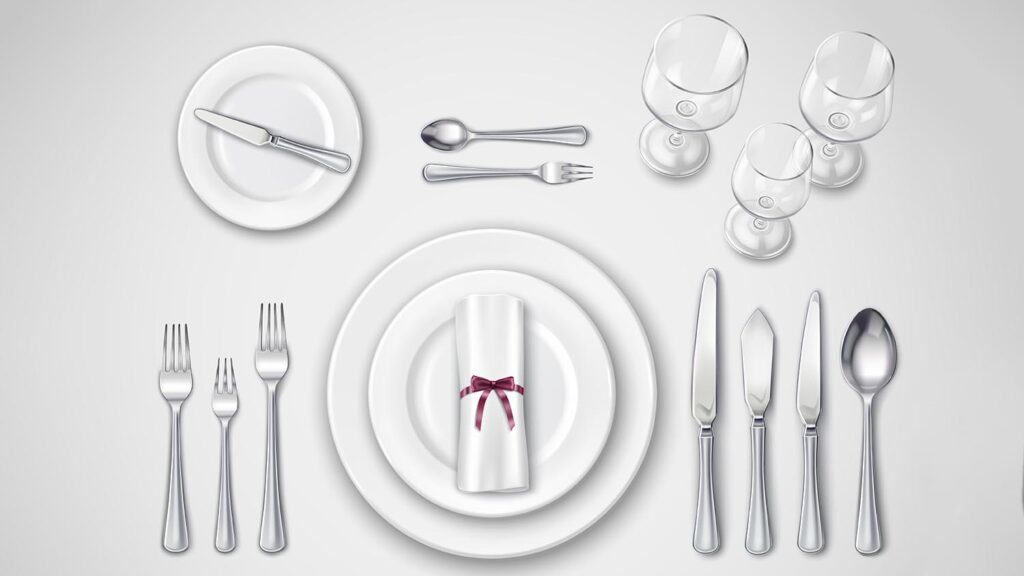
When my factory produces for a luxury hotel, the layout must be exact. But it's not a complicated secret; it's designed for efficiency and comfort. Here is how to set a standard 5-piece place setting.
The Logic of the Layout
Think about how you eat. You hold your fork in your left hand and your knife in your right. The layout simply puts the tools where you need them.
| Position | Utensil | Placement Logic |
|---|---|---|
| Far Left | Salad Fork | Used for the first course (salad), so it's on the outside. |
| Inner Left | Dinner Fork | Used for the main course, so it's next to the plate. |
| Inner Right | Dinner Knife | Used with the dinner fork, blade facing the plate for safety. |
| Middle Right | Teaspoon | Used before the main course (e.g. fruit cup) or with coffee later. |
| Far Right | Soup Spoon | Used for the soup course, which comes before the main. |
| Above Plate | Dessert Spoon & Fork | Placed horizontally above the plate, ready to be brought down. |
This order ensures that as each course is cleared, the next set of utensils is ready on the outside. It's a functional system that also creates a look of balanced, classic elegance.
What is the best way to store cutlery?
You have finally bought a beautiful, high-quality cutlery set. Now, you just toss it in a drawer, where it gets scratched, jumbled, and loses its shine, shortening the life of your investment.
The best way to store cutlery is in a compartmentalized solution that prevents pieces from touching and scratching. A divided drawer organizer is great for daily use, while a felt-lined canteen offers the best long-term protection.
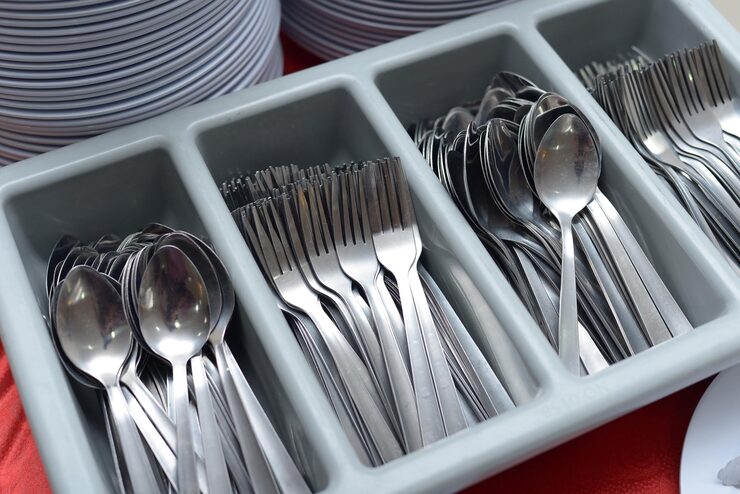
How you store your cutlery is just as important as how you wash it. Scratches and dings from improper storage are the most common cause of damage I see. Protecting your cutlery is simple and will keep it looking new for years.
Everyday Storage: The Drawer Organizer
For the cutlery you use every day, a good in-drawer organizer is essential. Don't just get an open tray; choose one with distinct, separate compartments for forks, knives, and spoons. This is the single most important step. It prevents the pieces from sliding around and rubbing against each other, which causes countless tiny scratches that dull the finish over time. Bamboo or wood organizers are excellent choices as they are gentle on the steel and can absorb trace amounts of moisture.
Long-Term Protection: The Canteen
For your best set of flatware, or pieces you only use for special occasions, nothing beats a traditional cutlery canteen or chest. These are the felt-lined boxes that often come with higher-end sets. The soft fabric lining provides a cushion that offers maximum protection against scratches. It also keeps the cutlery organized and free from dust. For silver-plated cutlery, a canteen is especially important as it helps slow down the tarnishing process by limiting exposure to air.
Conclusion
A full cutlery set is typically a 5-piece place setting. The rule is to use it from the outside in, and proper storage in organizers or canteens protects your investment.
